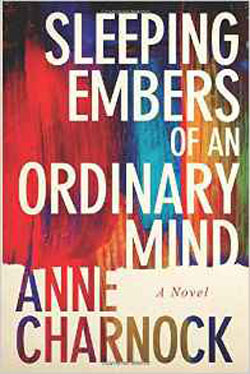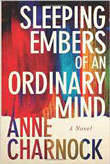
This original blog post by author Anne Charnock is part 1 of a 2 part series including an exclusive Q&A featuring questions from YOU, the readers. To win a copy of Anne's new book Sleeping Embers of an Ordinary Mind, make sure you're signed in, and ask the author a question in the comments section below. We'll choose the best questions to be included in the forthcoming Q&A, and those users will also win a copy of Sleeping Embers of an Ordinary Mind.
History is story telling, but some stories go untold. When it comes to my family history, I’ve learned to live with mystery and uncertainty. There are questions that will always go unanswered. Among old family papers, for example, I found an old, sepia photograph of a man and woman, probably in their sixties. It’s taken against the brickwork of a Victorian house—probably a miner’s or factory worker’s cottage. A dining chair has evidently been brought outside to stage the photograph.
I can imagine the couple’s conversation with the photographer. Who is the photographer—another relative, a friend, or a professional? I can see them shuffling through the back door of the house with the dining chair, positioning and re-positioning. She sits, he stands, and both are wearing their Sunday-best clothes.
More to the point, and the reason why this photograph is such a mystery to me, is that the man in the photo is the spitting image of one of my brothers. On the back of the photograph is a blunt note in my father’s elegant script: “My mother’s parents? I never met them.”
I presume they died before my father was born. I sifted through online records, and I discovered in the census data that my father’s guess was incorrect. His mother’s mother died sometime in her thirties. There’s no one left in my family to quiz about this rather handsome, if severe, couple.
Like many people, I’m often staggered how little I know about my immediate ancestors. Real life isn’t like the neatly rounded narratives of most fiction.
I learned a similar lesson in my first career as a journalist. Following most interviews, I’d have a nagging anxiety even when an interview had gone well and the interviewee had been generous and open. I’d walk away from the encounter knowing I had a good story—but had I discovered the story? Or had I failed to ask the question that would have elicited a key incident in my interviewee’s life? I learned to live with that doubt.
Doubt gives rise to mystery. Mystery provokes us to invent explanations.
In the case of my old family photograph, I look into the man’s eyes and I know we are related. I sense the genetic reach. Maybe my own personality is closer to this singular relative than any other member of my family. But I’ll never know his story. I now wonder if this is a photograph of my great-grandfather and his sister. That’s my favoured narrative at this point.
 When I wrote Sleeping Embers of an Ordinary Mind—a novel that spans from the Renaissance to the twenty-second century—these everyday mysteries were very much in my mind. The main characters are all connected through their artistic creativity of one type or another—pioneering art, copyist painting, craft-based hobbies.
When I wrote Sleeping Embers of an Ordinary Mind—a novel that spans from the Renaissance to the twenty-second century—these everyday mysteries were very much in my mind. The main characters are all connected through their artistic creativity of one type or another—pioneering art, copyist painting, craft-based hobbies.
In the future storyline, Toniah is an art historian. She takes a job at the Academy of Restitution whose mission is to secure overdue recognition for the many women overlooked by history. At the same time that she’s revisiting the historical record, Toniah is forced to re-evaluate her own upbringing after she uncovers a secret held tight by her late grandmother.
Every family has a story of uncovered secrets. They make each family distinctive.
In the present-day storyline, partly set in China, teenage Toni and her father are grieving over the death of Toni’s mother, who had died in a tragic accident some months earlier. Each conceals a truth about the circumstances surrounding the accident. Their wider family will never know the full facts. Toni becomes obsessed with the idea of early death. She starts a school history project, drawing in her friends to talk about relatives who died before having had children—dead ends on their family trees. And in the process, she discovers her own great-great-uncle’s past.
And, in the storyline set in Renaissance Florence, real-life Antonia Uccello, twelve-years-old, is learning to paint under the instruction of her father, the renowned painter Paolo Uccello. As a female member of a fifteenth century household, Antonia’s prospects are severely restricted, and her father and brother will decide her fate. In that era, many women “disappeared” into convents to allow their families to concentrate their wealth.
Paolo’s art provides a thread through all three stories, together with the notion of loss—both physical loss, and the loss of recognition within the historical canon. Why don’t we know more about Antonia Uccello? Why have none of her works survived?
When we look at our cultural history, we can ask: Where are the women?
In fiction, I find neat and tidy endings a tad false. As Frank Herbert, author of Dune, once said, “There is no real ending. It’s just the place where you stop the story.” Indeed, we are constantly revisiting and rewriting our own personal narratives. We’re all amateur sleuths, piecing together shards of information. No doubt we get some parts of the history right and some parts wrong, and how we see ourselves in the world is shaped by these fractured and uncertain stories.
I’m sad about the people left behind, those who should be a part of our official history, who even in the modern era didn’t make it into the family photograph album. We understand less of ourselves as a consequence.
Remember to ask the author a question in the comments below for a chance to be featured in the forthcoming Q&A and to win a copy of Sleeping Embers of an Ordinary Mind by Anne Charnock.
To enter, make sure you're a registered member of the site and simply ask a question below.
TIP: Since only questions from registered users will be evaluated, if your user name appears in red above your comment—STOP—go log in, then try asking again. If your user name appears in black above your question, You’re In!
 Sleeping Embers of an Ordinary Mind Q&A: NO PURCHASE NECESSARY TO ENTER OR WIN. A purchase does not improve your chances of winning. Open to legal residents of 50 United States, D.C., and Canada (excluding Quebec), who are 18 years or older as of the date of entry. To enter, complete the “Post a Comment” entry at https://www.criminalelement.com/blogs/2015/12/sleeping-embers-of-an-ordinary-mind-real-life-isnt-like-the-neatly-rounded-narratives-of-fiction-anne-charnock-q&a beginning at 10:00 a.m. Eastern Time (ET) December 2, 2015. Ends 2:00 p.m. ET December 11, 2015. Void outside the United States and Canada and where prohibited by law. Please see full details and official rules here. Sponsor: Ravenstone, imprint of Turnstone Press, 206-100 Arthur Street, Winnipeg, Manitoba R3B 1H3.
Sleeping Embers of an Ordinary Mind Q&A: NO PURCHASE NECESSARY TO ENTER OR WIN. A purchase does not improve your chances of winning. Open to legal residents of 50 United States, D.C., and Canada (excluding Quebec), who are 18 years or older as of the date of entry. To enter, complete the “Post a Comment” entry at https://www.criminalelement.com/blogs/2015/12/sleeping-embers-of-an-ordinary-mind-real-life-isnt-like-the-neatly-rounded-narratives-of-fiction-anne-charnock-q&a beginning at 10:00 a.m. Eastern Time (ET) December 2, 2015. Ends 2:00 p.m. ET December 11, 2015. Void outside the United States and Canada and where prohibited by law. Please see full details and official rules here. Sponsor: Ravenstone, imprint of Turnstone Press, 206-100 Arthur Street, Winnipeg, Manitoba R3B 1H3.
Anne Charnock's debut novel, A Calculated Life, was a finalist for the 2013 Philip K. Dick and Kitschies Golden Tentacle Awards. Her writing career began in journalism and her articles appeared in the Guardian, New Scientist, International Herald Tribune, and Geographical. Although Anne's education initially focused on science, she later attended the Manchester School of Art, where she gained a master's degree in fine art. Sleeping Embers of an Ordinary Mind(47North) is her second novel.

Do you have any suggestions for readers who find it difficult sometimes to follow fragmented novels such as this one?
I would like to know if there are places you can research family history that don’t cost money?
Do you reseach lot before writing or just add detail about people, places that know a lot about? Like Steven King with Maine?
I would like this.
This would be great, thanks.
Thank you!
Don’t forget – this isn’t simply a comments sweepstakes! We’ll be picking the best questions to be featured in the forthcoming Q&A, so to win, you must ask a question.
Thank you
Have you ever written about real time people or is it all fiction ?
Sound like a good winter read, thanks
Hello, Your book’s story line is fitting like
a glove to my personal life, for the past year.
Losing my 96 year old dad, and there are still
so many questions to ask him about our family
history… Do you think it would be helpful to ask
the family patriarchs and/or matriarchs questions about family history, and record for safe keeping. I do believe that during the time
of my parents youth, not as much was discussed or talked about, like now.
Many thanks, Cindi
Have you ever thought of creating a fictionalized story about the couple in the photograph? Using the brief background you found and tying your family, specifically your father, into their story?
What is that beautiful tree and where is it located? Thanks.
Have you run across an artist whose paintings have reflected his/ her family and their secrets? I consider myself an artist but hace never thoughtto do this.Maybe I should.
Your post was captivating and extremely interesting. I, too, think about my ancestors and their lives. My late mother left me many photograph albums filled with many photos of family members whom I never knew and cannot recognize. It saddens me since I realized too late that I should have shown more interest in my background. How did you create this fascinating historical filled with memorable characters and locales. Did you travel to many farflung areas?
When you have this wonderful talent for storytelling can you lose yourself within the storyline? Are the characters friends or family members with whom you have a close relationship? I was intrigued since storytelling is an art which gives me a great deal of pleasure and entertainment since it is meaningful and profound. Your post resonated with me.
Doing our own research on my father’s side of the family, we were able to visit the area where his maternal grandparents came from and wished we could have stayed longer in order to explore more. We were also able to find out a little bit more about mom’s maternal side of the family (she has some family still alive and we were able to talk with a cousin).
Have you considered, per the question regarding the book’s storyline, writing about any of the female ancestors in your family (non-fiction or a fictionalized account)?
Doing our own research on my father’s side of the family, we were able to visit the area where his maternal grandparents came from and wished we could have stayed longer in order to explore more. We were also able to find out a little bit more about mom’s maternal side of the family (she has some family still alive and we were able to talk with a cousin).
Have you considered, per the question regarding the book’s storyline, writing about any of the female ancestors in your family (non-fiction or a fictionalized account)?
Where did you go to search for information on your family history?
How do you come up with the titles? Do they lead the stories or the story lead them? Thank you.
i am excited to read this, i love to read
What secret do you think would be the most interesting to find out that your grandparents had kept from you? For example, why are two of my grand uncles riding a fake giraffe and laughing hysterically in an old picture?
What’s your research process?
When writing fiction, how do you know when you’ve reached the end of the story – or at least a good place to stop?
What was your favorite part of the book and why?
Where did your inspiration to become a writer come from? Have you always enjoyed writing since a child or did you decide later on to become a writer?
It’s easy to understand why women’s lives are so ill-represented in written history and/or family chronicles. But did any women themselves undertake the task of writing about the women in their family history, nor officially but somewhat in secret, in order to preserve the story of the women in their family? Or did women, many of whom were not taught to read, not think their lives were important enough to chronicle?
have you written anymore books
sounds great sign me up
I like the title; what made you choose it to name your work?
Why did you decide on such a long timeline for the book, from the Renaissance to the twenty-second century?
Good deal, count me in!
How’d you keep track of your storylines?
This is a book in which I would like to read. I would like to thank you for giving all of us this chance to win this fine giveaway.
What is your favorite food?